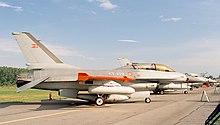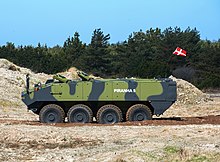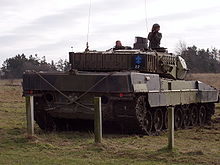Danish Armed Forces
|
|||
| guide | |||
|---|---|---|---|
|
Commander in Chief de jure : |
Margrethe II Queen of Denmark | ||
| Commander in chief de facto : | The Minister of Defense | ||
| Defense Minister: | Trine Bramsen | ||
| Military Commander: | The Chief of the Armed Forces ( Forsvarschefen ) General Bjørn I. Bisserup as of January 2017 | ||
| Headquarters: | Copenhagen | ||
| Military strength | |||
| Active soldiers: | 17,000 (2016) | ||
| Reservists: | 12,000 + 51,000 Heimwehr volunteers | ||
| Conscription: | 4–12 months | ||
| Resilient population: | 1,088,751 | ||
| Eligibility for military service: | 18 to 49 years of age | ||
| Share of soldiers in the total population: | 0.33% | ||
| household | |||
| Military budget: | $ 3.593 billion (2016) | ||
| Share of gross domestic product : | 1.16% (2016) | ||
| history | |||
The Danish Armed Forces ( Danish Det Danske Forsvar , Forsvaret for short ) are the armed forces of the Kingdom of Denmark , which also includes the Faroe Islands and Greenland .
tasks
The main task of the armed forces is to defend Danish sovereignty , guarantee the existence and integrity of an independent Denmark and ensure the peaceful further development of the state and the world with regard to human rights. The main tasks are:
- Cooperation with other states within the framework of NATO membership
- Control of the borders of Denmark, Greenland and the Faroe Islands
- Cooperation with non-NATO members in Central and Eastern Europe
- Conflict prevention through international peace missions
- Development of a total defense through cooperation with civil organizations
High command and organization
The king or queen is de jure commander in chief of the armed forces. The current head of state is Queen Margrethe II. In practice, the defense minister is in command. The chief military superior is the Forsvarschefen with the rank of general or admiral . Since April 2015 there has been a joint command staff ( Vaernestabe ) for all branches of the armed forces, which is located in Karup .
The armed forces consist of the armed forces:
- Army (Hæren) ,
- Marine (Søværnet, Kongelige Danske Marine) ,
- Air Force (Flyvevåbnet) ,
- Home Guard (Hjemmeværnet) .
history

In the Middle Ages and in the early modern period, Denmark was a Northern European great power with a corresponding army and a large fleet. The transfer of the office of fleet commander by King John I in 1510 to the noble Henrik Krummedike is seen in Denmark as the foundation of the Danish Navy . Since then a fleet has been organized with its own warships and a permanent crew. During the 15th to 17th In the early 20th century, the Danish armies were usually made up of mercenaries. Only after the end of the Second Northern War (1655–1660) and the loss of the Skåne provinces to Sweden, in connection with the introduction of absolutism ( lex regia of 1665), a standing army was set up , which was not disbanded even in peacetime. The officer corps and large parts of the men came from German-speaking countries at this time ; Until 1772, the official command language in the Danish army was therefore German. Only the "national" regiments that were set up in phases in the 18th century consisted mainly of Danes, Norwegians and Schleswig-Holsteiners. Except for two "recruited" regiments, the regiments in the Kingdom of Norway consisted of Norwegians. The navy was a domain of the Danes and Norwegians, there was hardly any German element as in the army and civil administration.
The early modern period was mainly determined by conflicts with neighboring Sweden . With the Peace of Brömsebro in 1645, Denmark had to cede the previously Norwegian territories of Jämtland and Härjedalen as well as the islands of Gotland and Saaremaa (Danish: Øsel ) to Sweden. With the Peace of Roskilde in 1658 Denmark finally lost its own provinces east of the Öresund Skåne , Blekinge and Halland, which had already been pledged, to Sweden, which could not be regained in subsequent Danish-Swedish wars.
In the Napoleonic Wars , Denmark first tried to maintain armed neutrality , but was attacked by Great Britain and lost its fleet in the naval battle of Copenhagen . After Denmark had entered into an alliance with France , the subsequently rebuilt fleet was defeated again by the Royal Navy in the Second Sea Battle of Copenhagen and had to be extradited to Great Britain. The army took part in two battles against the Allied troops in what is now Schleswig-Holstein near Bornhöved and Sehestedt in 1813, while resistance was still being offered against Swedish troops in Norway in 1813/14. After the Peace of Kiel on January 14, 1814, the army and navy were rebuilt, with Norway, now Swedish, falling out of the military system of the entire Danish state . Until the Schleswig-Holstein uprising (1848-1851) the Danish army did not wage war. With a half-hearted reform in 1842 an attempt was made to adapt the military system and in particular the army supplement to recent developments. But it was not until the civil war between Danes and German Schleswig-Holsteiners that general conscription was introduced in 1849 . After the defeat in the second German-Danish War and the loss of Schleswig in 1864, an era of neutrality began for Denmark .
First World War and the interwar period
During the First World War , the policy of neutrality, based in particular on security by the navy, was successful. In the interwar period Denmark disarmed, and at times the dissolution of the army and navy was even discussed. The fortifications of the capital Copenhagen were preserved, but they no longer met modern requirements for a fortress. Some forts were abandoned in the 1920s and 1930s, such as the landside forts from 1920 and Fort Trekroner in 1932.
Second World War
Although Denmark and the German Reich had in 1939 a non-aggression pact, Denmark was approved by the Wehrmacht on 9 April 1940 occupied . The army and navy were initially retained. For fear of an Allied invasion of Jutland , the occupying power demanded the evacuation of the peninsula by Danish troops. The Danish high command refused, the troops stayed. The German question as to whether the troops would behave neutrally in the event of an invasion was answered with We will do what is right for Denmark .
In 1941, under German pressure, five disarmed torpedo boats had to be delivered to the German Navy . As a sign of protest, on the orders of King Christian X, the flag on Sixtus Bastion in Copenhagen, which is a symbol of Danish sovereignty, was raised at half-mast on the day of delivery. All ships in the Danish Navy followed suit. On August 29, 1943, a state of emergency was declared by the occupying forces . The Danish army was disarmed - after a brief resistance, which mainly served to make weapons and equipment unusable; the officers were interned by the Wehrmacht. The Danish fleet command had foreseen an encroachment of the occupying power on the fleet and prepared a corresponding plan of operations. The ships should try to reach neutral Sweden or, if this was not possible, be scuttled by their crews themselves to prevent them from falling into the hands of the Germans. Most of the ships were sunk themselves, some units managed to escape to Sweden. The largest ship in the Danish Navy, the ironclad Niels Juel , was on a training voyage in the Isefjord on August 29, 1943. The Niels Juel received in the port of Holbæk by radio command, visit Swedish territorial waters. The ship was placed in full combat readiness and ran north towards the Kattegat at maximum speed. At the exit of the Isefjord, the Niels Juel was attacked by German aircraft - the Danish ship returned fire. The battle in the Isefjord began : attacks were repulsed with on-board weapons, but during another bomb attack the fire control system on the Niels Juel failed and the ship had to be aground near Zealand . The army and the navy were dissolved by the occupying forces.
In 1944, the Danish Brigade was set up as a police unit in Sweden and the Danish flotilla was formed from the ships and boats of the Navy that had fled to Sweden . The brigade (around 5000 men) crossed to Denmark on May 5, 1945 and took control of the country together with British troops.
After the Second World War

The Danish army participated in the Allied occupation of Germany since 1947 in the form of the Danish "Germany Brigade". The experiences of the Second World War led to the abandonment of neutrality. Denmark is a founding member of NATO . In 1950 the Air Force was organized as an independent armed force from the aviation forces of the Navy and the Army Aviation Corps. In the 1990s, the Danish army was restructured in order to better implement the operational scenario of crisis management and the deployment of rapid reaction forces for peace missions of the UN, OSCE or NATO. In Denmark there is compulsory military service (which does not apply to the Faroe Islands), but the number of volunteers has been so high since 2010 that it is de facto not applied.
The Danish armed forces were the first and only during the Cold War since 1962 - together with the West German Bundeswehr - to combine parts of the respective armed forces under a joint multinational headquarters of the Allied Land Forces Schleswig-Holstein and Jutland as a corps staff of NATO. After its decommissioning in 1999, this staff became part of the Multinational Corps North-East .
The Danish Army has been deployed in Afghanistan with up to 750 soldiers under an ISAF mandate since 2002 . In 2003, the Danish army took as part of the so-called the willing coalition on Iraq war part. The engagement began in April 2003 and included a maximum of 545 members of the army. The last units were withdrawn by December 2007. The contingent known as Dancon / Iraq (Danish Contingent) was stationed in Al Qurnah and near Basra and tasked with training Iraqi security forces and securing Basra Airport . Seven Danish soldiers were killed during the operation, three of them in booby traps , two in combat and one each in friendly fire and in a car accident.
As in England, the Danish army maintains two guard units for representation purposes, the Den Kongelige Livgarde (on foot) and the Gardehusarregimentet (on horseback). These are normal combat units and are equipped with combat equipment such as battle tanks.
The Danish Navy maintains the Frømandskorpset , a combat swimmer unit, for triphibian command operations .
The Danish Home Guard Hjemmeværnet is responsible for the territorial security of the Danish national territory . This is subordinate to the Fernspähkompanie Hjemmeværnets Særlig Støtte og Rekognosceringskompagni (German: Heimwehr-Spezialunterstützungs- und Aufklärungskompanie).
The Arktisk Kommando (Arctic Command), formed in 2012, serves to defend the Faroe Islands and Greenland .
To defend Greenland , 60 soldiers from the Greenland Command of the Danish Armed Forces were stationed in Kangilinnguit ( Grønnedal in Danish ). In Daneborg , the Danish military maintains a dog sled patrol with the Sirius patrol .
Following the withdrawal of the US Iceland Defense Force from Iceland in 2006, the Danish Navy is becoming more committed to maintaining Iceland's defense capability .
Personnel and equipment
Workforce
- Professional and temporary soldiers in 2016:
- Officers in the ranks from Lieutenant Colonel / Frigate Captain to General / Admiral 344
- Officers in the ranks from lieutenant to major / corvette captain 3,041
- NCOs 4,194
- Teams 7,391
- Officials and civil employees in 2016: 4,885
- 2011: 25,109 (Army 10,146, Air Force 3,476, Navy 3,204, others 8,283)
For comparison:
- 2002: 21,300 (Army 12,800, Air Force 4,500, Navy 4,000)
- 1984: 31,400 (Army 18,100, Air Force 7,400, Navy 5,900)
- 1966: 49,000 (Army 32,000, Air Force 10,000, Navy 7,000)
Equipment of the army
Armored vehicles
- Main battle tank
-
Armored personnel carriers and armored personnel carriers
- 45 CV 9035DK
- 22 Piranha III
- 50 M113A2
- 11 Sisu XA-180 (medical tank)
- Engineer tanks
- 10 bridge layers Biber with 20 armored rapid bridges
- Armored recovery vehicles
- 19 armored recovery vehicles 2
- 5 armored recovery vehicles Wisent (upgraded armored recovery vehicles 2 to meet the requirements of the Leopard 2)
artillery
- 15 CAESAR on 8x8 chassis
- Self-propelled howitzers
- Rocket launcher
- 12 MLRS (medium artillery missile system)
Air Force Equipment

Planes
- Warplanes
- Transport aircraft
- Training aircraft
- Saab T-17 supporter
helicopter
- Eurocopter AS 550 Fennec , light liaison helicopter
- AgustaWestland AW101 Series 512 Merlin (8 for SAR and 6 for transport tasks in the inflow)
- 8 “Sea Lynx” , on-board helicopter
Navy equipment

The Navy is undergoing a process of renewal. In 2004, all five remaining submarines were canceled without replacement, but new surface units were built.
- 3 anti-aircraft frigates Iver-Huitfeldt class (1 in service, 2 under construction), dissolved the Corvette of Niels-Juel class from
- F361 Iver Huitfeldt ; F362 Peter Willemoes ; F363 Niels Juel
- 2 command and support ships of the Absalon class
- L16 absalon ; L17 Esbern Snarre ;
- 4 Thetis class Ocean Patrol Vessel
- F357 Thetis ; F358 triton ; F359 Vædderen ; F360 Hvidbjørnen
- 2 inspection ships (Ocean Patrol Vessel) of the Knud Rasmussen class
- 1 Agdlek class patrol cutter
- 6 Diana- class patrol boats
- 6 multi-purpose boats of the Holm class
In addition, the royal yacht Dannebrog (A 540), the three Danish icebreakers A551 Danbjørn , A552 Isbjørn , A553 Thorbjørn as well as the Danish environmental protection and sea rescue ships and boats and a number of other support ships and boats belong to the Navy.
See also
- The Congregational Livguard
- Gardehusarregimentet ( Guard of the Danish Royal Family)
- Hjemmeværnet
- Sirius patrol
- History of the Danish Navy
- List of women in the military
swell
- ↑ a b c Defense Expenditure of NATO Countries (2010-2017) Press Release Communique PR / CP (2017) 111, NATO Public Diplomacy Division, June 29, 2017 (PDF)
- ^ " Aim and Tasks" ( Memento of October 17, 2010 in the Internet Archive ) Danish Defense, April 24, 2008 (accessed December 1, 2008)
- ^ Journal 4/2010 of the Danish Post on the occasion of the stamp anniversary issue 500 years of the Navy
- ↑ Cf. in detail on the Danish army up to 1863 in general and in Schleswig-Holstein in particular: Eva Susanne Fiebig, Jan Schlürmann : Handbuch zur Nordelbischen Militärgeschichte. Armies and wars in Schleswig, Holstein, Lauenburg, Eutin and Lübeck 1625–1863 / 67. Husum 2010, ISBN 978-3-89876-317-2 .
- ^ Peter Hertel Rasmussen: Den danske Tysklandsbrigade 1947-1958, Odense 2019
- ↑ Grønlands kommando: History ( Memento of February 12, 2012 in the Internet Archive ) (Danish)
- ↑ Grønlands kommando: Opgaver ( Memento from February 11, 2012 in the Internet Archive ) (Danish)
- ↑ a b "Samlet antal ansatte i Forsvarsministeriets koncern (ekskl. Beredskabsstyrelsen og Forsvarets Efterretningstjeneste) pr. July 1st, 2016." Forsvarsministeriet. 2018-08-27.
- ↑ Facts and Figures - The Danish Armed Forces. (pdf) Danish Armed Forces, accessed February 16, 2015 .
- ^ International Institute for Strategic Studies: The Military Balance. 2002
- ↑ Armed Forces 1984/85. The "Military Balance" of the International Institute for Strategic Studies, Koblenz 1985, p. 84 ff.
- ↑ Friedrich Wiener: Foreign armies. The armies of the NATO countries. Vienna 1966, pp. 105, 106.
- ↑ https://www.fmn.dk/videnom/Documents/Bilagsbind-1-FKOM-2008-beretning.pdf page 47
- ↑ " floppy hats INSTEAD OF SUBMARINES Danes looking for agents by display ," Spiegel Online, March 15, 2005 (Accessed December 10, 2008)

